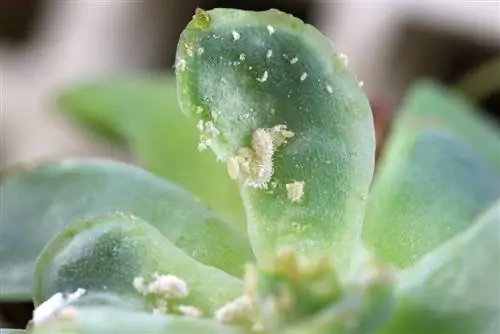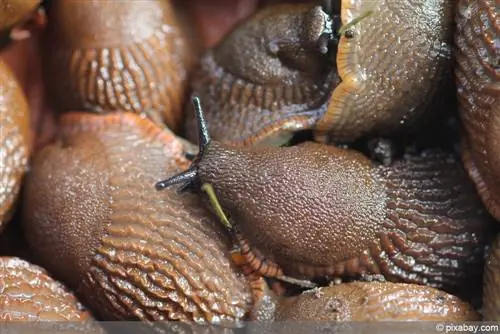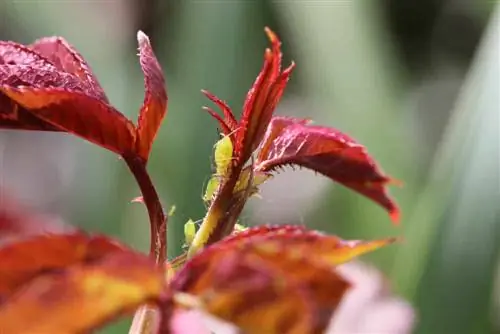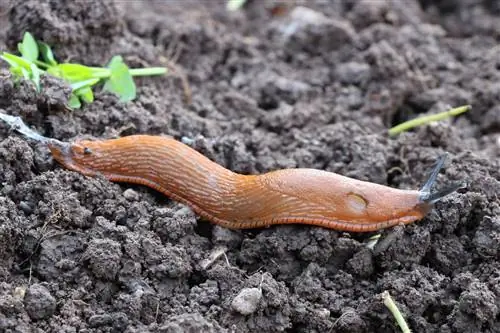- Author admin [email protected].
- Public 2023-12-17 03:39.
- Last modified 2025-01-24 12:45.
Many biological remedies help against snails; often at the same time using leftovers and fertilizing/strengthening the plants. An exciting step that at the same time leads towards an ecologically self-regulating garden and household cycle with little waste:
Effective biological remedies against snails
The direct, rapid defense of a snail population that is exploding in the lettuce bed (depending on the type of snail, 30 to 300 mini snails crawling out of their eggs) is best achieved with plant manure, which fertilizes the plants and gives the snails their appetite spoil. The nice thing about it is that all possible leftovers can be put to good use:
Alum water
Dissolve 40 g of potassium aluminum sulfate (pharmacy, or already available for dyeing hydrangeas blue) in 10 l of boiling water. Spray undiluted cold onto plants and soil. Approved as a food additive E 522, so it can also be added to plants that are ready for harvest.
Begonia manure
If the first flower of the begonia on the balcony is cut away to make room for plenty of subsequent flowering, it can immediately come in handy: Crush the begonia flowers and add ten times their weight of water (500 g=5 l), 2 Let stand for hours, strain, spray on plants and soil.
Fernwort manure
Does your fern need a good pruning? Great, put 5 kg of fresh fern fronds in 10 l of water, let it steep, dilute 1 to 10 and spray over the ground and plants. You can also dry the fern fronds in advance, take 500 grams of them and boil them in a large pot of water.
currant leaf extract
The pruning of the currant bush can also be used to drive away snails: strip the leaves from the branches and chop them up, put 1 kg of currant leaves in a bucket of water, let it stand for a few hours, strain and spray.
Coffee
The leftovers from the morning coffee, which have already been boiled down a little on the warming plate, find useful uses: when cool, spray them on plants and soil. You should spare very sensitive vegetables from the caffeine shower; you can drive away the snails with coffee grounds on the roots. For plant life, coffee (the little bit that gets into the ground when spraying) and coffee grounds are fertilizer; the mollusc snail dies from even the smallest amount of caffeine.
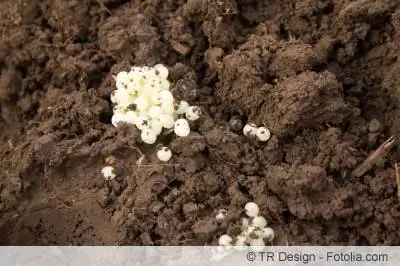
Compost manure
1 scoop of compost on a bucket of water (or better yet, three times the amount in the mortar tube) and let it sit until no more foam forms. Dilute 1:20 and water around the plants, this dilution should have a neutral taste.
Liverwort extract
Liverwort extract is available to buy ready-made, and it has been scientifically proven that e.g. B. Arion lusitanicus, the dreaded Spanish slugs, do not touch lettuce leaves sprayed with liverwort extract.
Moss manure
Liverwort extract is the safe bet, but all mosses contain secondary plant substances that they have produced as defenses against pests. And all native mosses have to fend off native snails, so the moss in the lawn is definitely worth trying to use for a useful “secondary use” after you have painstakingly picked it out of the lawn: let a few handfuls of moss soak in water for three days, strain and use Watering plants. The native snails also include the infamous Spanish snail, which was not brought to us from Spain, scientifically and genetically proven to be a Central European snail of the genus Arion (of which the researchers did not find a single one in Spain). They have discovered many new, previously unknown gene variants of the Arions, which seem to cross briskly.
Rhubarb leaf manure
Finally the rhubarb leaves also have a meaning. The manure from rhubarb leaves is tasteless, also fertilizes the vegetable plants and drives away snails. However, the leaves of rhubarb are not eaten because they contain unhe althy amounts of oxalic acid. The manure could also increase the oxalic acid content of the fertilized plants - so it is better to spread it on vegetable plants that are eaten cooked (and throw away the cooking water). Add 1 kg of rhubarb leaves to 1 bucket of water, let it steep for a day, then pour undiluted around the endangered plants.
Pine cone manure
Collect 1 kg of pine cones and let them steep in water for 24 hours in a large stainless steel or enamel pot. Bring to the boil, let stand for 1/2 hour, strain, pour cooled broth around the roots. Because of the resin in the broth, nothing to ward off snails on vegetables that are ready to be harvested.
Tomato shoot manure
Also a nice way to use leftovers: put the exhausted side shoots of tomatoes in a bucket of water, let them sit for 24 hours, water around the plants, but not over the leaves. Again 1 kg to approx. 10 l, the manure can be diluted 1:2 to 1:5.
Wormwood Manure
Watering with a 1 to 10 diluted wormwood manure repels snails, ants and black weevil larvae. However, this manure is so bitter that the lettuce should not be harvested the next day either
Natural enemies
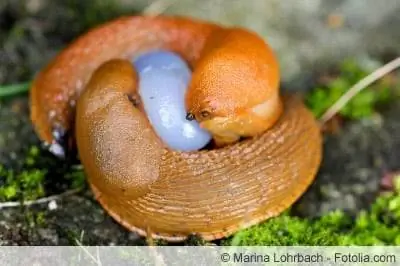
You can also leave direct defense against an exploding snail population to animal snail enemies:
1. Hedgehog
They can be invited into the garden with a hedgehog house and they love eating snails.
2. Running ducks
If you feel like having a few new pets, have your lawn mowed by friendly running ducks, who will also take care of any snails.
3. Marten
If the marten wasn't allowed to move into the attic, it may have moved in somewhere in the garden. Not so bad, the predator is not interested in your plants, but in rats, mice, snails (carrion, rotten fruit, wasp nests)
4. Mole
The annoying but protected mole at least makes itself useful by cleaning up all the snails (and wireworms) on your property and loosening up the soil in the process. By the way, it doesn't harm your plants.
Moreover, slowworms, firefly larvae, frogs, toads, ground beetles, and shrews like snails to eat; The song thrush builds a special thrush forge for destroying shell snails: a stone with which it violently knocks the snails out of their shells.
Mechanical snail defense
Even without manure and without animals, you can make it so difficult for snails to access your most beautiful vegetable plants that they move hungry to the neighbor (not really, but at least to the garden areas where they can nibble):
1. Defense through snail walls
Snails are naturally repelled by any “wall” made of natural material that is difficult to crawl over. You can choose between ash, eggshells, chopped thorn branches, rock dust, sawdust
2. Cultivation out of reach
from snails offers a salad tree that can stand just as well in a garden bed as on the balcony.
3. Growing or growing in pots
If you don't give birds, squirrels, mice and snails a leaf from the young plants that are supposed to produce a delicious harvest, growing them in a pot is a good idea. They plant such strong plants that a snail that is still wandering around despite all other measures can no longer harm them, and the harvest is possible much earlier.
4. Wire mesh to protect trees
If you plant young trees that have particularly high ecological value, they are often particularly liked not only by bees and other insects, but also by snails. Such as B. the bee tree Euodia hupehensis, young bee trees should therefore be surrounded with a fine-meshed wire mesh sleeve to protect against snails.
5. Mulching against snails
Works with any material that is difficult to overcome when crawling, ideally very fine mulching material. How about fine flax shives, a traditional, soil-forming mulching material that supports plant growth as it breaks down and repels snails very well. To order e.g. B. at www.waldland.at/de/waldviertler_flachshaus/flachs_und_hanf.
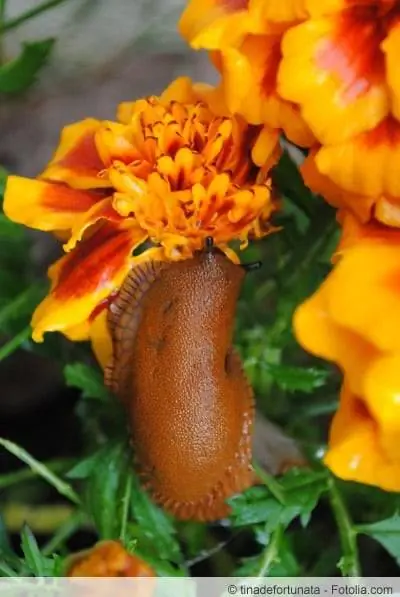
6. Safe storage
Pumpkins, cucumbers, etc. can be stored from fruit formation to harvest maturity on a surface (plastic, hard foam, wood) that no snails can climb on.
7. Access impossible
is also what it means for snails when you grow the most tender vegetable plants in raised beds. This is not the only reason why the harvest will be magnificent, the earth will also warm up earlier in the raised bed, you can harvest multiple times or bring critical southern vegetables to maturity.
Relaxed gardeners are not necessarily against snails
Relaxed gardeners live not against nature, but with nature, and they gladly accept the help that nature's different organisms offer. In the case of snails, this initially helps with soil cultivation; they feed on dead plant material, which is broken down by the snail and becomes humus much more quickly (“through it”).
Nudibranchs do this too, “he alth police snails” also eat carrion and feces of other small animals, but in turn are themselves an important building block in the food web, for all the wild animals mentioned above (and sometimes also for the snails themselves, shell snails eat). Nudibranchs (eggs), all snails eat the carrion of other snails).
Snails therefore have an important ecological significance, and overwhelming slug populations only make relaxed gardeners sit up and take notice because they indicate a disruption to the natural balance in the garden.
Snail control then primarily consists of measures that improve the balance again, more attention to natural design so that many natural snail enemies can settle; combined with curbing the current increased snail population through the means mentioned in this article.
Relaxed gardeners not only know the biological remedies that are effective against snails, but also know how to make the snails work for them:
“Directing” snails
Relaxed gardeners don't want to eradicate the snails in their garden, but they want to decide for themselves where the snails work for them. This requires snail steering, and it works like this:
Anti-snail plants
Where the snails don't want to go, these plants are planted (around the bed) that are supposed to drive away snails:
- Bearded carnations, Dianthus barbatus
- Wood anemone, Anemone nemorosa
- Loosestrife, Lysimachia clethroides
- Busy Lizzies, Impatiens walleriana
- Chamomile, Matricaria chamomilla
- Nasturtium, Tropaeolum
- Chervil, Anthriscus cerefolium
- Lavender, Lavandula angustifolia
- Liverwort, Hepatica nobilis
- Marjoram, Origanum majorana
- Moss saxifrage, Saxifraga bryoides
- Feverfew, Tanacetum parthenium
- tansy, Tanacetum vulgare
- Rosemary, Rosmarinus officinalis
- Sage, Salvia officinalis
- Storksbill, Geranium
- tree peonies, peonies
- Thyme, Thymus vulgaris
The liverwort extract mentioned above also comes from a plant, the liverwort Porella obtusata, a completely normal moss in southwest Europe. Hardly available as a plant in normal stores, but today there are internet exchanges for everything
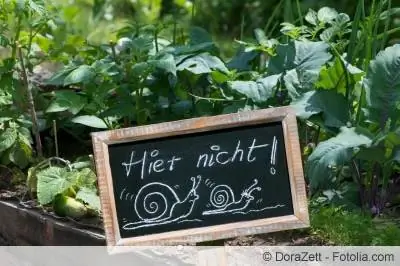
Many beautiful plants that are supposed to slow down the snails as “natural snail fences”. However, this is about nature, and nature is constantly evolving - it could be that “your snails” have gotten used to the strong smell of rosemary or even find chamomile to be very fragrant. All of these snail defense plants will not immediately drive away snails as young plants. Young plants still contain few secondary plant substances, so they have not yet developed the typical aroma that the snails should not like, but are simply fresh green, i.e. H. “tasty” from a snail’s perspective.
Snail attractant
If snails are driven away somewhere, there must be something somewhere else where they can migrate or sit down, e.g. B. Garden areas with the following plants:
- Flower pruning to promote new growth produces delicate young flowers that snails often find delicious.
- Fertilizer with a lot of nitrogen increases the nitrate content of plants; What should be avoided in salad can make snails happy elsewhere.
- French sorrel, Rumex x acetosa, is not only particularly tasty for gourmets, but snails also regularly make the delicate leaves their favorite dish. It doesn't matter, just plant the vigorous dock where you want the snails to gather. It's sturdy and easy, if you plant enough of it you can still collect enough for the kitchen after the snails have been collected and moved to the compost to work.
- Perennial clover grass is a hot tip for attracting snails. There are ready-made seeds for dry locations (red clover, alfalfa, white clover, meadow fescue, smooth oats, timothy grass) and rainy locations (red clover, white clover, German ryegrass, meadow fescue, timothy grass), an idea for a beautiful piece of meadow at the back of the garden.
- Parsley tastes so good to snails that it could overgrow one of the central snail collection points from which the snails are transported to the compost for drudgery.
More snail favorite plants:
- Coleus, Solenostemon scutellarioides
- Strawberries, Fragaria
- Radish, Raphanus
- Student flowers, Tagetes patula
Whether the snail attractants “work” is just as uncertain as with the anti-snail plants. But a piece of garden in which you plant a few of the alleged snail favorites and otherwise simply dig in every unnecessary young plant (except for snail repellent plants) could prove to be an ideal snail collection point if the compost is already overstocked.
Why “only” biological agents?
When there are so many nice chemical agents that make work easier? More and more home gardeners are working without pesticides, initially simply because more and more pesticides are proving to be highly dangerous and unhe althy.
And these pesticides don't really make work easier either. Not in the home and allotment garden anyway, if you want to use the funds correctly (and everything else is forbidden), you'll spend most of the season measuring and calculating.
But overall they never make work easier, and a planting soil in which many artificial pesticides are used is never easy to care for, that is a fairy tale from the chemical (pharmaceutical) industry that produces the pesticides.
But rather this planting soil can no longer be used as planting soil in a surprisingly short time. There are currently increasing voices in research according to which it is not (organic) agriculture without pesticides, but intensive agriculture with pesticides will plunge the world into a hunger crisis at some point. Replenishing such chemically contaminated soil takes a long time and is quite labor-intensive. In addition, the pesticides regularly harm organisms in the environment, including humans; are manufactured using a lot of energy from irreplaceable resources; Even small amounts disrupt the balance of pests and beneficial insects.
If in doubt, this leads to a diabolical cycle: New pests immigrate, multiply unhindered and are destroyed with even more poison - at some point the vegetables are no longer edible, the pests are resistant and the gardener is sick from all the poison.
More and more people are refusing to participate in this cycle of madness, and organic snail management is a step on that path that every home gardener can do well.


